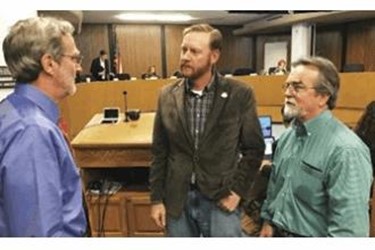Project Backers Seek Investments From Water Bond
By Christine Souza

Moving closer to final decisions about which California water projects will receive funding from a bond passed by voters in 2014, the California Water Commission heard presentations regarding about a dozen storage projects that have applied for bond funding. Potential projects include large-scale surface storage, reservoir expansions, groundwater projects and recycled-water projects.
Through the Water Storage Investment Program, applicants are competing for a portion of $2.7B in storage funding available through the Proposition 1 water bond. The water commission will decide how to allocate bond money for the public benefits of storage projects.
Applicants made 15-minute presentations to the commission at a meeting in Sacramento last week, providing details about the public benefits of each project, such as improvements for the ecosystem, water quality, flood control, emergency response and recreation.
Speaking to the commission, California Farm Bureau Federation Director of Water Resources Danny Merkley reinforced the organization's support for large-scale surface projects identified by the Cal-Fed Bay-Delta Program, including the proposed Sites Reservoir, Temperance Flat Dam and Reservoir and expansion of Los Vaqueros Reservoir.
"California will continue to face intense water challenges," Merkley said. "Now more than ever, California's water system needs a more flexible, environmentally friendly and sustainable solution for diverting and storing water during periods of excess flows for human and environmental uses during dry periods."
Sites Reservoir would be a large, off-stream storage project in Colusa and Glenn counties. Proponents said Sites would provide storage capacity of 1.8 million acre-feet of water and an annual yield of 500,000 acre-feet—additional surface water for cities, farms and the environment that would also help relieve pressure on groundwater.
Sites Project Authority General Manager Jim Watson described Sites as an ambitious project that would "provide multiple benefits from drinking water, agricultural water, water quality, flood reduction, recreational opportunities, integration with renewables, and we can help address climate change. Most important are the ecosystem benefits that this project can provide."
The proposed Temperance Flat Dam and Reservoir would be built within the existing Millerton Lake, upstream from Friant Dam on the San Joaquin River in Fresno and Madera counties. Backers said the project would add 1.26 million acre-feet of storage, including 390,000 acre-feet of active storage capacity, on the upper San Joaquin River, creating greater flexibility, reducing pressure on groundwater and providing fisheries benefits.
Speaking on behalf of the San Joaquin Valley Water Infrastructure Authority, Bill Swanson of Stantec Consulting Services noted that the project provides "increased local operating flexibility and tremendous lift to the groundwater sustainability agencies' ability to achieve sustainability under (the Sustainable Groundwater Management Act)."
Steve Worthley, San Joaquin Valley Water Infrastructure Authority president and Tulare County supervisor, described the serious water situation the San Joaquin Valley faces, especially in light of new requirements under SGMA.
"Without new water sources, (coming into compliance under SGMA) is quite simply an impossibility. Farmers are very efficient with their use of water, but at the end of the day, we are going to lose perhaps millions of acres of agricultural land. We need this opportunity to recharge our groundwater," Worthley said.
The proposed expansion of Los Vaqueros Reservoir, which is located southwest of the Sacramento-San Joaquin Delta in Contra Costa County, would store additional water to serve 500,000 people and would hold transfer water for south-of-delta contractors, including agricultural districts and Central Valley wildlife refuges.
"In terms of agricultural supply, we are looking to improve supplies, especially in dry years, and also provide additional operational flexibility, where right now a lot of the folks in the Central Valley south of the delta have a lot of constraints on their operations," said Marguerite Patil, Contra Costa Water District special assistant to the general manager.
Jason Peltier, executive director of the San Luis & Delta-Mendota Water Authority, said expansion of Los Vaqueros "would facilitate water transfers when we can't rely on the Central Valley Project, and it will provide much-needed water to the wetlands."
CFBF Second Vice President Shaun Crook, who attended the commission meeting, said Farm Bureau and other agricultural organizations supported Proposition 1 in order to spur investment in such surface-storage projects.
"I don't think the question is, 'Can we afford to do it?' I think the question is, 'Can we afford not to do it?' That's how important the storage needs are. We've got to fund and construct additional water storage now, so we're not still having this conversation in 40 years," Crook said.
Other projects described to the commission included a recycled water for groundwater project for agricultural irrigation in Sacramento County, and groundwater banking projects.
Bill Bird, Sacramento County Farm Bureau executive director, spoke in favor of the South Sacramento County Agriculture and Habitat Lands Program, saying farmers in the region improved crop production in the past year because they had access to clean and reliable irrigation water supplies.
"Any project that adds to it is something that we are going to support," Bird said.
Regarding the Kern Fan Groundwater Storage Project, Rosedale-Rio Bravo Water Storage District General Manager Eric Averett said, "The project expands upon existing and successful water management and banking relationships," adding that "groundwater banking has a number of environmental benefits."
Jason Gianquinto of the Semitropic Water Storage District described the Tulare Lake project, which would have the capacity to bank up to 120,000 acre-feet a year of Kings River floodwaters in the historic Tulare Lake lakebed; water would be conveyed from there via the California Aqueduct to the Sempitropic Water Bank in Kern County.
By next June, the commission will determine the maximum bond funding available to eligible projects. To learn more about the projects, see cwc.ca.gov/pages/WSIP.aspx.
Source: California Farm Bureau Federation
